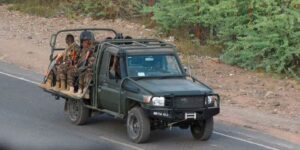The life of a bandit in Kenya’s insecurity-prone North Rift is one of sworn secrecy, military-like ranks, uneducated young men dangerously suspicious of their educated peers, and top-notch intelligence gathering that would rival that of any organised force.
The Saturday Nation has pieced together the dangerous, daring lives of the bandits, who have troubled communities for decades, with Kenya Defence Forces (KDF) troops deployed to calm the restive region. During the last six months, 100 civilians and 16 police officers have been killed—an average of one person every two days in what is becoming Kenya’s biggest internal security problem.
Two weeks ago, the government, faced with an escalating situation, deployed KDF soldiers to help police officers to quell tensions, but the bandits’ guns have not gone silent, and have gotten even more daring, with an ambush on a KDF convoy in Kainuk this week.
Multiple interviews with reformed bandits, the clergy, national government officials and locals have helped the Saturday Nation paint a picture of who Kenya’s North Rift bandits are, and why the bid to quell the ‘disturbed and dangerous zones’ is not a walk in the park.

For most armed cattle rustlers, the ‘training’ starts at a tender age; young boys get no formal schooling and start ingraining life in the bush—living by the gun. Here, boys, sometimes as young as eight or nine, are separated from their mothers and taught “the way of men”, starting with how to hold and shoot a gun, coupled with lessons on how to survive the hardship of the terrain.
Mr Julius Akeno lives in Tiaty at the heart of the banditry-prone region. He has seen it all and documented it in a book, Patrons of Wild Suguta Valley. He writes: “At a tender age, boys were separated from their mothers and were not allowed to sleep in their mothers’ huts. Their place is aperit, an open fireplace in the compound. They were trained to be alert always, even when asleep. They were told to sleep with their eyes closed but their ears opened. No one should walk in unheard and find them asleep. It would be a mistake punishable by several lashes of the cane. The rough handling of young boys will make them hardy to prepare them for a tough life ahead.”
Target communities
The second most important—and perhaps the most sophisticated—aspect of the life of a bandit is intelligence gathering. The ‘recce’, as they call it, is carried out long before a raid. The job description of those in this category is simple: To know where the target communities herd their livestock, where they live and even get acquainted with the escape routes while driving away their ‘loot’.
“For the whole day, they monitored the movement of animals and the herders in detail. They noticed that only armed men were herding the cattle. Two groups headed straight to one of the nearby highest hills to have a better view of the surrounding land. Mortolee had chosen a small hill that could not attract the attention of the herders. He knew places to avoid. Herders on patrol liked climbing high places to view their livestock,” Mr Akeno tells of a raid, in his book.

Such ‘recce’ missions, Mr Akeno says, can take even a whole month or more.
“There are those categories of the rustlers who are skilled in intelligence and their specific work is to spy on the communities far away to be attacked. Not anyone can carry out such missions but only those who have been proved and tested. These people are very well respected in the community because this is the hardest of the assignments than the raid itself,” explains Mr Akeno.
Ranks
Colonel (Rtd) Moses Kwonyike says cattle rustlers usually sleep outside, mostly on riverbeds or cowsheds from a tender age, so that they can be privy to what is going on in their surroundings, and can subdue their perceived enemies before they ambush them. From his long-term study of their ways, the retired soldier says bandits wake up early in the morning before anyone else to monitor all the routes in a bid to find out who passed through, check footprints to know which type of shoe and other details.
The rustlers have ranks and those who kill have some visible markings on their bodies depending on the people he has killed. For instance, when a rustler kills a man, four cuttings are done on his body and you may find one having several of the marks on his body, an indication that he has killed so many people.
“Rustlers are also rewarded by the community and elders if they prove their prowess in defending their community and are given more cattle. The more cuttings you have, the more you are glorified. They are called generals and these are some of the indications sustaining the age-old practice,” says Mr Kwonyike.
Enock Pkemoi, 26, a reformed bandit from the far-flung Loyamoi in Tiaty West, dropped out of school when he was in Standard Three and was immediately drawn into the life. At the time, there was a devastating drought and herders had to drive their livestock further afield, even as far away as Kainuk in neighbouring Turkana County, in search of pasture and water. That is when he had to learn to use a gun—an essential skill for a herder in the volatile region where cattle theft is common.

Herders, he said, would walk hundreds of kilometres, despite the harsh weather and the rough terrain, in search of water and pasture. That made him hardy and he grew accustomed to jungle life. They would stay for several months away from home, until rains returned.
“Senior herders used to train us in how to use guns and the dos and don’ts of the battlefield, just in case the perceived enemy struck. In a short time, I turned into a sharpshooter,” he explained.
Pkemoi graduated from a herder to a bandit, stealing animals in Baringo, West Pokot, Turkana and Elgeyo Marakwet, the risks notwithstanding. He stayed away from home from 2009 to 2012.
“I remember one time we raided a community in Kainuk, Turkana. There were more than 50 of us and everyone had a role to play, from those who could shoot and steal to others shielding the group or driving away the stolen livestock,” he said.
Three of his closest friends from the same village also joined him and were recruited as raiders. One of them was shot dead. “We took his gun and left the body to be eaten by hyenas. Of course we had no time to carry it home, hundreds of kilometres away, for burial. We later divided the livestock among ourselves and each took eight cows,” he narrated.
No burials
Funerals for those who die during raids are highly discouraged. Here, men who come out of raids unscathed are more respected than those who die. When a rustler dies in a raid, his counterparts take his rifle and leave his body in the bush for wild animals to feed on, an indication that their ultimate goal is not only to steal livestock but also come out unhurt.
Joseph Chesang, a former police reservist (NPR) from the porous Kesumet in Baringo North, says that apart from being acquainted with firearms at a tender age, the criminals have some other techniques that show they might be getting training from skilled people, including ex-soldiers. The rustlers are normally armed with AK-47 and G3 rifles and carry bullets in water containers to conceal what they are carrying, said Mr Chesang who served for seven years as a reservist.
Another reservist, Jackson Chemjor who has also served for seven years at the volatile Chemoe border in Baringo North, said the bandits, who invade an area in numbers, have more than enough ammunition and can fight the entire day without depleting them.

“Because they walk for long distances, they carry sugar, water, soaked maize on their backs to replenish their energy, normally tagged in goatskin bags. With this consignment, they will never get tired as they rejuvenate their energies by taking the sugar,” said Mr Chemjor. “They know how to handle all sophisticated firearms despite being illiterate. During raids, the way they take cover and lay ambushes is a clear indication these people are coached by skilled men.”
A security officer who has served in the area narrated how daring the young bandits are. The raiders, he stated, are well conversant with the porous and rugged terrain and that gives them an upper hand and easily take advantage to ambush police officers. Sometimes the attackers destroy communication masts to disable communication of security officers deployed in the area and locals from making a distress call in case of an attack. For local administrators, efforts here often come to naught as it often means hunting for people armed to the teeth—and ready to use their firearms.
Lokis Chief Johnston Long’iro said most of the criminals flee when they get wind of a looming disarmament exercise, negating efforts to track them.
“They flee the villages and go far away to the neighbouring counties and countries such as Uganda. Tracking such characters is no joke,” said Mr Long’iro.
A chief from Kerio Valley, who sought anonymity, claimed that though they sometimes get the names of those behind the spate of banditry and livestock theft, the suspects flee to other areas and change their names completely. “Most of the armed criminals have no identity cards and they purposely do so to hide from the authorities just in case their crimes are known. The few who have IDs flee to remote areas where they cannot be tracked and change their names.”
The bandits’ way of life and the support system goes deeper than just the men with guns in hunt for cattle. It starts with the elders at home, and the women left behind. Before the raids, the bandits receive blessings from ordained elders, who tell them which routes to use to avoid being cornered and whether the mission would be successful. The elders, including seers and magicians, are highly respected in the Pokot community.
Praise songs
Women also fuel the perennial problem by ridiculing their sons who have opted to go to school instead of going on livestock theft missions. “Women are the catalysts. When their sons go for raids and come back with cattle, they compose songs to praise them, while those who haven’t come back with anything are ridiculed and seen as lesser men. They also don’t encourage their sons to go to school,” said Col (Rtd) Kwonyike.
He suspects ex-military men may have a hand in the practice. “I remember in the early 1990s, there was mass recruitment of the Pokot to the military as an affirmative action. When a majority was recruited into the military, most of them had ulterior motives as some wanted to be pilots, communication experts so that they could be intercepting military communication, but because of lack of education, they failed in their mission,” said Col (Rtd) Kwonyike.
“Eventually, most of them retired from the army with combat tactics from the military. When they went home, they became the instructors of those bandits in the bush. The expertise the criminals are employing when fighting are gained from the retired soldiers. They should be investigated because these are the characters responsible for charging the criminals,” he added.
Credit: Source link